Gomer Lab PNAS Publication: Learning to shoo cells away
By: TAMU Biology
 Although a considerable amount is known about how eukaryotic cells move toward a signal (chemoattraction), relatively little is known about how cells move away from a signal (chemorepulsion). Learning how to repel cells from a location could be quite useful. For instance, in patients with acute respiratory disease (ARDS), immune cells called neutrophils flood into the lung airspaces, effectively drowning the patient. Repelling neutrophils out of the lungs could save the life of the patient.
Although a considerable amount is known about how eukaryotic cells move toward a signal (chemoattraction), relatively little is known about how cells move away from a signal (chemorepulsion). Learning how to repel cells from a location could be quite useful. For instance, in patients with acute respiratory disease (ARDS), immune cells called neutrophils flood into the lung airspaces, effectively drowning the patient. Repelling neutrophils out of the lungs could save the life of the patient.
The Gomer lab, starting with basic research on the model eukaryote D. discoideum, previously identified a chemorepellent used by these cells, and from this found a neutrophil repellent that showed efficacy in mouse models of ARDS. This first type of repellent blocks part of the random movement of cells so that they move in any direction except toward the source of the repellent. In a recent study, the Gomer Lab found a new type of repellent consisting of polymers of phosphates (polyP). Rather than use the same basic mechanism, the polyP causes cells to actively move away from the polyP source, indicating that there exist two basic chemorepulsion mechanisms, and that these could potentially be used simultaneously for better therapeutics for ARDS.





